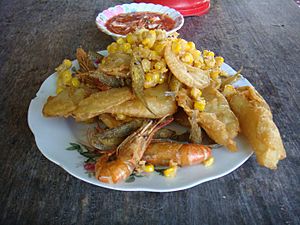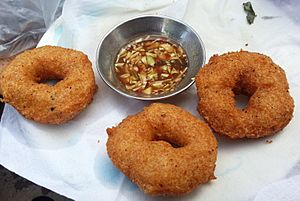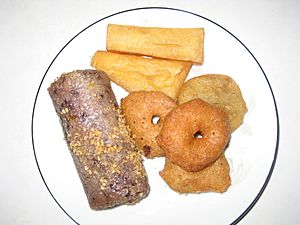Burmese fritters facts for kids

A plate of Burmese fritters
|
|
| Course | Breakfast, snack (mont) |
|---|---|
| Place of origin | Myanmar (Burma) |
| Region or state | Southeast Asia |
| Associated national cuisine | Burmese |
| Main ingredients | Various |
| Similar dishes | Vada, tempura, pakora, okoy, pholourie, bakwan |
Burmese fritters (Burmese: အကြော်; pronounced: [ʔət͡ɕɔ̀]) are popular snacks from Myanmar (also known as Burma). They are made by taking vegetables or seafood, dipping them in a special batter, and then deep-frying them. When you see a mix of different kinds of fritters, it's called a-kyaw-sone.
Most Burmese fritters are savory, meaning they taste salty rather than sweet. They often use ingredients like beans and pulses (which are like dried beans or lentils). They are a bit similar to vada, a fried snack from South Asia.
People in Myanmar usually eat these fritters for breakfast or as a snack during teatime. You can find them at tea shops and from street vendors. Fritters are often served on their own with a special dipping sauce. This sauce is usually sour and sweet, made from tamarind.
Sometimes, fritters are used as a topping for other popular Burmese dishes. For example, fritters made from gourd, chickpea, and onion are cut into small pieces. These pieces are then eaten with mohinga, which is Myanmar's national dish. Fritters also go well with sticky rice called kauk hnyin baung. They are also served with a green Burmese sauce called chin-saw-gar or a-chin-yay. This sauce is often made from chili sauce mixed with vinegar, water, cilantro, chopped tomatoes, garlic, and onions.
Different Kinds of Fritters


There are many different kinds of Burmese fritters. Some popular ingredients include diced onions, chickpeas, potatoes, various leafy vegetables, and even bananas. Here are some common types:
- Bazun khwet kyaw (ပုစွန်ခွက်ကြော်) - These fritters are made with bean sprouts and prawns. They are a bit like Filipino okoy.
- Kawpyan kyaw (ကော်ပြန့်ကြော်) - These are fried spring rolls, similar to popiah. They are filled with vegetables like jicama, carrots, and bean sprouts.
- Mandalay pe kyaw (မန္တလေးပဲကြော်) - Fritters made from kidney beans.
- Mat pe kyaw (မတ်ပဲကြော်) or Mandalay baya kyaw (မန္တလေးဗယာကြော်) - These are fritters made from black gram beans. They are similar to medu vada from South India.
- Mont kat kyaw (မုန့်ကပ်ကြော်) - These are vegetable fritters coated in a rice flour batter.
- Bu thi kyaw (ဘူးသီးကြော်) - Slices of fried bottle gourd.
- Kyet thun kyaw (ကြက်သွန်ကြော်) - Fried shallots or onions, similar to pakora.
- Myinkhwa ywet kyaw (မြင်းခွာရွက်ကြော်) - Fried bunches of pennywort leaves.
- Mont hsi kyaw (မုန့်ဆီကြော်) - A fried pancake with slices of jaggery (a type of unrefined sugar).
- Ngaphe kyaw (ငါးဖယ်ကြော်) - Deep-fried fishcakes made from the meat of the bronze featherback fish.
- Ngapyaw kyaw (ငှက်ပျောကြော်) - These are banana fritters. They are usually made with very ripe bananas and don't have extra sugar or honey added.
- Pe kyaw (ပဲကြော်) - Fried split pea crackers. These are often used to decorate mohinga.
- Pyaungbu kyaw (ပြောင်းဖူးကြော်) - Corn fritters, similar to Indonesian bakwang jagung.
- Samuza (စမူဆာ) - Deep-fried dumplings usually filled with potatoes.
- Tohu kyaw (တိုဟူးကြော်) - Fritters made from Burmese tofu.
- Yangon baya kyaw (ရန်ကုန်ဗယာကြော်) - Fritters made from yellow split peas. They are similar to pakora, falafel, and pholourie.
- Yikyakway (အီကြာကွေး) - These are deep-fried Chinese crullers, which are like long, twisted doughnuts.
Fritters in Other Places
"Egg bhejo" or "egg bejo" (Tamil: முட்டை பேஜோ) is a common street snack found in India. It actually came from Myanmar. This snack is made of hardboiled eggs stuffed with fried onions, garlic, coriander, and chili. It's seasoned with tamarind and lemon juice. Egg bhejo is often eaten with khow suey or atho. These are both Indian versions of Burmese noodle salads. The name 'bhejo' comes from the Burmese word pe kyaw (ပဲကြော်), which is the fried split pea cracker often served with these Burmese dishes.

